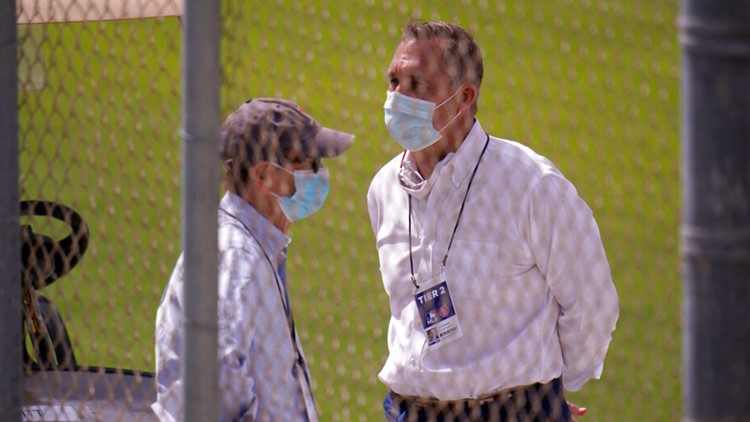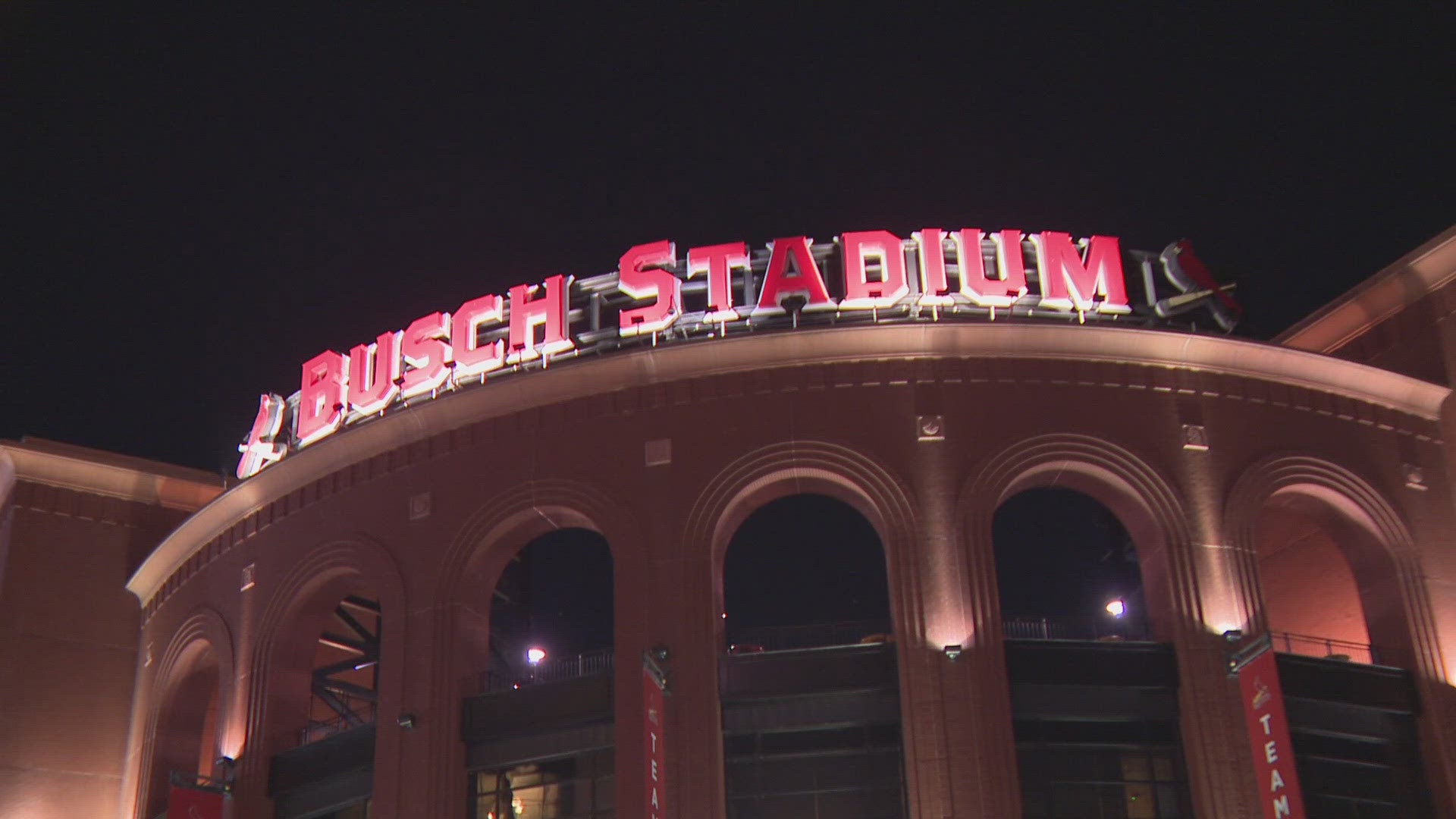ST. LOUIS — Of all of the questions which will need to be addressed by the Cardinals at some point this offseason, there are two that seemingly far out-weigh all of the rest.
How much money do the Cardinals have to spend, and how should they spend it?
The questions, of course, are intertwined – which probably means the answers will be as well.
The expiring contracts of Matt Carpenter, Carlos Martinez, Andrew Miller, Dexter Fowler and Kwang Hyun Kim will free up a little more than $60 million from the team’s 2021 payroll of $163 million. The Cardinals will have to pay a $2 million buyout to Carpenter and $500,000 to buy out the option for Martinez, so the “available” money is now down to $58 million.
The Cardinals have already spent $10.5 million from that total with the raises to Adam Wainwright and Yadier Molina. Paul DeJong also is due a $2 million raise on his multi-year deal. Adding the players on multi-year deals – Nolan Arenado, Paul Goldschmidt and Miles Mikolas – the team has $110 million committed to the six players under contract for 2022.
More of that “available” money also will be handed out through raises to players eligible for arbitration. This will be the second year of arbitration for Jack Flaherty, Harrison Bader, Alex Reyes and Jordan Hicks. Among the players eligible to file for the first time are Hudson, Tyler O’Neill and Giovanny Gallegos.
Once all of those players have been accounted for, the Cardinals can then decide what kind of salaries they can afford when they begin pursuing players through free agency or trades – with the two positions most frequently mentioned being shortstop and a starting pitcher.
While significant outside acquisitions will certainly be discussed, there is no guarantee that anything will develop beyond the talking stage.
The free-agent shortstop class includes terrifically talented players who will be paid handsomely by somebody. Would adding Corey Seager or Trevor Story upgrade the Cardinals’ lineup? Without question – but at what cost? With Arenado and Goldschmidt already due a combined $60 million for each of the next three years, would the team really want to commit close to $100 million – more than half of its payroll – to just three players?
What will also affect the Cardinals' decision is their internal evaluation of how Edmundo Sosa played this season – and what they believe would be the realistic expectations about his performance if he was a full-time starter in 2022. They also will have to look at DeJong and make a decision if the last two years is a downward trend in his performance that will continue or can he bounce back to the level he established earlier in his career.
Another part of the decision also has to be who the Cardinals project as their starting second baseman in 2022. There are two obvious internal choices – the starter this year, Tommy Edman, or their top prospect in the minors, Nolan Gorman, who spent 2021 making the transition to the position. If Gorman is deemed ready by the organization, similar to how they opened a spot in right field for Dylan Carlson this year, then Edman will no doubt become part of the shortstop conversation.
So if the Cardinals decide not to pursue one of the top free agent shortstops, the most likely spot to spend money will be on a starting pitcher – with St. Louis native Max Scherzer at the top of seemingly every fan’s wish list.
The same philosophy about signing the 37-year-old Scherzer likely would apply to the shortstop decision, however – would the Cardinals be willing to commit another $30 million or more a year to a player of that age? Scherzer also likely would be looking for more than a one-year deal.
Only the Cardinals can answer that question. It’s their money.
Here is a rundown of some other questions facing the Cardinals as the offseason begins, with possible answers:
Does the starting rotation need help?
This is a sub-question to how much money the Cardinals will have to spend and where to spend it. Even if they don’t have the appetite to bite on Scherzer, there will be other free agent starters available – but does signing any of them make the rotation better?
Five months before the team will gather for the start of spring training in Jupiter, Fla., the Cardinals 2022 rotation, on paper, would appear to be Flaherty, Wainwright, Dakota Hudson, Miles Mikolas and Reyes – assuming the team follows through on its intention to move him back to a starting role next year. Combined, four of those five – all but Wainwright – made 24 starts this year, 15 by Flaherty and nine by Mikolas, in a season that saw 13 pitchers make at least one start.
That projected rotation does not include Hicks, who will be tried as a starter in the Arizona Fall League the next two months. Nor does it include Jake Woodford, Johan Oviedo or two potential free agents who finished the year in St. Louis, Jon Lester and J.A. Happ. The organization’s top pitching prospect, Matthew Liberatore, also will come to Florida ready to compete for a spot in that rotation after his first full year at Triple A.
Even without Lester or Happ, that is a total of nine potential starters, making it questionable if there is room for an outside addition.
What about the bullpen?
The mid-season additions of Luis Garcia and T.J. McFarland helped restore order to the Cardinals bullpen this season, and it would make sense for the team to bring both of them back for 2022. They would join a group headed by Gallegos, who figures to go into next year as the established closer. Genesis Cabrera and Kodi Whitley should return as well, and the Cardinals are hopeful Ryan Helsley will be healthy when the year begins and can re-establish himself as part of the late-inning mix.
That adds up to six of the projected eight relievers. It’s possible they could bring back Wade LeBlanc, a free agent, who could be a swing candidate as a potential starter if needed, or move one of the starting candidates to the bullpen next spring as a potential long reliever.
Who is ready to make the step up from the minors?
Two candidates already have been discussed, Gorman and Liberatore, best friends since they were teammates as kids growing up in Arizona. Both almost certainly will make their major-league debuts sometime in 2022.
A player who might arrive before them, and in fact already made an appearance on the roster for the wild-card game, is Juan Yepez, acquired when he was just 18 from the Braves in 2016 for Matt Adams. Now 23, the right-handed Yepez is primarily a first baseman but he likely will try to gain experience at other positions while playing in the Fall League the next two months. What Yepez really does is hit – a combined 27 homers between AA and AAA this season. He would seem to be in the team’s plans for 2022 both as a hitter off the bench and a potential candidate to at least split the DH duties.
What should be the plan for the DH?
Could this be the spot where the Cardinals chose to spend some money? It likely depends on how they decide they want to fill the spot, assuming that the universal DH goes into effect in 2022 as is expected. With a limited DH in use in recent years, the Cardinals have chosen to rotate the spot among their regulars, giving them a day off their feet. They could do that again next year, as well as using that spot to get at-bats for players such as Lars Nootbaar and Yepez who normally would be limited to pinch-hitting duties.
Or, they could sign a free agent, especially if he hits left-handed, and make him the primary DH. One candidate if that happens should be Kyle Schwarber.
Should there be any changes to the coaching staff?
The answer to this question might have been different a month ago. Did the winning streak, and claiming the second wild-card spot, save anybody’s jobs? In all likelihood, yes. Without the streak, the inconsistent offense could have prompted a change in hitting coaches. Now, however, it seems likely that the organization will want to keep things the same at least for the start of next season to see if what changed in September will continue, or the team will return to its off-and-on performance from the first five months of this season.
Will Mike Shildt get a contract extension?
This is probably the easiest question on the list to answer. With Shildt heading into the last year of his managerial contract in 2022, he almost certainly will get a two or three-year extension sometime this winter. He has led the team into the playoffs each of his first three full years as the manager, and there is no indication anyone in the organization has not been pleased with his performance.
Is the bench in need of another hitter?
The answer is yes, but that new hitter, or two, could perhaps come from internal roster moves. With Carpenter gone, one spot is open even if nothing else changes. Yepez is in line for a bench spot, and if Gorman becomes the regular second baseman, another bench spot will go to whoever is the odd-man-out at shortstop, most likely Sosa. DeJong also will factor into the mix if Edman slides over to become the starting shortstop. Also factoring into the bench’s makeup, of course, will be whatever the Cardinals decide to do about filling the DH spot.
Can the organization add depth to the minor league rosters?
While not having a direct effect on the major-league club, at least at the beginning of the season, the Cardinals need to upgrade the rosters of their minor-league teams, especially at the two highest levels. While winning games is not the ultimate priority in the minors, the performance of the organization’s four full-season teams in 2021 left a lot to be desired. The four combined were a whopping 109 games under .500. Three of the four (Springfield, Peoria and Palm Beach) finished in last place in their respective leagues.
The Cardinals made a conscious decision to push many of their younger prospects to higher levels in 2021, despite almost all of them missing the 2020 season because of the pandemic, and the results showed. Whether those players will be able to catch up to the level of their leagues this year could have a major impact on the success of the major-league team in the years to come.
Follow Rob Rains on Twitter @RobRains
Photo by AP courtesy of KSDK Sports



